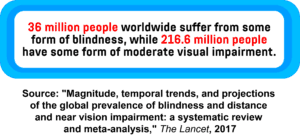- Bionic eyes will allow wearers to see the infrared spectrum
- Researchers developed artificial skin that allows the wearer to feel magnetic fields and sound wave vibrations
- A brain implant uses machine learning algorithms to enhance human memory
- This portable exosuit increases human endurance
- What will future humans look like?
Thanks to major technological advancements, especially in the field of medicine, humans today live much longer than their ancestors. In fact, the average life expectancy has doubled since the 19th century, when it stood between 30 and 40 years. By 2016, the global life expectancy at birth reached 72 years, according to the World Health Organization. This naturally led some people to ask what the natural limits of the human body are and whether we could do anything to overcome those limitations. Merely delaying death wasn’t enough anymore, people also wanted to find a way to upgrade their bodies and allow them to perform feats that go beyond their natural capabilities.

The idea of augmenting human bodies has been around for quite some time, but it started to gain steam in recent years, once technology was finally advanced enough to allow us to start turning that idea into reality. Often referred to as biohacking, the concept revolves around using technology to upgrade the human body in a way that will improve its physical and cognitive performance. Some of the solutions designed to do just that are already here, and the early results seem very promising.
Bionic eyes will allow wearers to see the infrared spectrum
Blindness affects more than 36 million people around the world, while 216.6 million people suffer from moderate visual impairment. For years, scientists have been looking for a way to restore sight, but success proved to be elusive. That may be about to change, though. A California-based visual prosthetics company called Second Sight Medical Products recently unveiled a new bionic eye system that could enable blind people to see again.

The Orion Visual Cortical Prosthesis System, as the device is called, consists of a pair of glasses equipped with a small camera that captures images, a video processing unit that converts the images into electrical impulses the wearer can interpret, and an implant that stimulates the user’s brain to recreate what the camera sees. The implant is installed directly into the patient’s brain through a small craniotomy in the back of their head, above the occipital lobe. “They put the electrode array in there between the two halves of the brain against the visual cortex,” explains Second Sight’s CEO, Will McGuire. “Then they basically screw the electronics package into the skull, just next to the craniotomy.” Within this electronics package, there’s a small transmission coil that allows the device to receive data and power from the system’s external parts wirelessly.
The procedure to install the device requires an overnight stay in the hospital and a recovery period of three to four weeks. Once the device is turned on, the user should be able to start seeing spots of light, or phosphenes, which appear as the visual cortex is electrically stimulated by the implant’s 60 electrode array. To be able to provide the most distinct and discernable spot of light possible, each electrode needs to be individually tuned, which can take weeks, or even months. The team then proceeds to establish a spatial map that will ensure that each electrode energises the correct spot on the patient’s brain. To achieve that, the user is required to repeatedly tap the specific spot on the surface of a tablet when a certain electrode is energised. Once the accuracy of the mapping is confirmed, the data is fed into an algorithm that converts the video from the camera into stimulation parameters that recreate the scene for the user.
The company doesn’t plan to stop there, though. The next step involves increasing the electrode count to 150-200 to improve image fidelity. They’re also exploring the possibility of using distance filtering to give the user depth perception, which is currently not possible, as the device uses just one camera. “If we had two cameras perhaps we could give them the option of only seeing objects that are within 10 feet or objects that are greater than 10 feet,” says Nik Talbot, Second Sight’s senior director. “What that would do would clear up the image for them. Right now, they’re picking up things that are near and far. That can distort what they’re seeing and make it more difficult to interpret.” The team is also looking into adding face- and object-recognition features to help the user identify what’s in their field of view. A thermal camera could be another future addition. It would enable the user to see the infrared spectrum, allowing them to detect where people are in the room, for example, or whether the stove is hot.
https://www.youtube.com/watch?v=ezVNM05GeUE
Researchers developed artificial skin that allows the wearer to feel magnetic fields and sound wave vibrations
Researchers at the University of Connecticut and University of Toronto have developed a groundbreaking sensor that allows artificial skin to sense pressure, vibrations, and even magnetic fields. Using this innovative technology, the researchers were able to create prosthetic skin that could restore the sense of touch for people like burn victims and amputees. “The type of artificial skin we developed can be called an electronic skin or e-skin,” explains Islam Mosa, a postdoctoral fellow at UConn. “It is a new group of smart wearable electronics that are flexible, stretchable, shapeable, and possess unique sensing capabilities that mimic human skin.”
The sensor consists of a silicone tube wrapped with a copper wire and filled with an iron oxide nanoparticle fluid. The nanoparticles constantly move around the tube, producing an electrical current that’s picked up by the copper wire. When pressure is applied to the tube, the current changes. In addition to being able to sense environmental changes just like human skin, the artificial skin also has some capabilities that go far beyond anything humans can do. It can, for example, feel magnetic fields and sound wave vibrations. “A big motivation to develop this e-skin sensor was to extend the capabilities of this technology to superhuman abilities,” says Abdelsalam Ahmed, a postdoctoral fellow at the University of Toronto. “We proved that e-skin can alarm humans of the surrounding danger before accidents happen.”
This technology could have a number of potential applications in many different fields, including hazard prevention electronics, rescue robotics, and next-gen remote healthcare monitoring. However, before that happens, the researchers need to find a way to ensure that the e-skin is completely biocompatible. They’re also working on making the tubular prototype flatter to make it look more like actual skin.
A brain implant uses machine learning algorithms to enhance human memory
A team of researchers led by the psychologist Michael Kahana from the University of Pennsylvania recently announced they’ve found a way to use machine learning algorithms to decode and enhance human memory by delivering precisely timed electrical pulses directly to the brain.
To test their method, the researchers implanted between 100 and 200 electrodes into the brains of 25 epilepsy patients and used them to record brain activity during memory tasks. The patients were asked to read a list of words and try to memorise them, while the researchers collected thousands of voltage measurements per second from each of the implanted electrodes. This allowed them to see what happens in the brain when it tries to memorise something. They did the same for patients’ recall, recording which brain activity patterns were associated with remembering or forgetting a word. The researchers repeated the process multiple times until they had enough data to create patient-specific algorithms that could predict which words patients were likely to remember.
That’s not all, though. In addition to reading neural activity, the electrodes can also stimulate it, allowing the researchers to aid the formation of memories in real time. Each time a patient sees a new word, the algorithm would be able to determine whether the brain would remember it based on electrode activity. “A closed loop system lets us record the state of the subject’s brain, analyze it, and decide whether to trigger a stimulation, all in a few hundred milliseconds,” says Kahana. According to the researchers, this allowed patients to improve their ability to recall words by an average of 15 percent.
While this number doesn’t sound particularly impressive, it’s certainly promising and proves this is an idea worth exploring further. The next step should be to test whether adding more electrodes would allow algorithms to decode even more neural signatures and improve their specificity. More training data could also have a positive effect on the algorithms’ performance.
This portable exosuit increases human endurance
Scientists at Harvard University recently unveiled a new portable exosuit designed to improve the wearer’s performance while walking and running. Weighing just five kilograms, the exosuit is made of cloth components and is worn around the waist and thighs, allowing the wearer to conserve energy by helping them extend the hip joint. “Essentially, we’ve kind of re-created an artificial muscle on the outside of the human body that’s working in parallel with the underlying biological muscle,” says the lead researcher, Conor Walsh, an engineering professor at Harvard.
Since walking and running involve different motions, the scientists had to find a way to let the device know when the wearer switches between the two. To achieve that, they developed a gait classification algorithm that allows the exosuit to sense when the wearer transitions from a walking gait to a running gait and automatically change modes. According to scientists, an indoor test revealed that a person wearing the exosuit reduced their energy expenditure by 9.3 per cent when walking and 4 per cent when running. The exosuit proved to be very versatile, performing admirably during uphill walking, at different running speeds, and during overground testing outside.
The lightweight exosuit could have a number of useful applications. For example, it could be used to help soldiers carry heavier loads, help industry workers perform physically demanding tasks, or help recreational hikers improve their endurance. Future versions of the exosuit could also be used to improve the mobility of people affected by medical issues like stroke, multiple sclerosis, Parkinson’s disease, or spinal cord injury. “This breakthrough study gives us a glimpse into a future where wearable robotic devices can improve the lives of the healthy, as well as serve those with injuries or in need of rehabilitation,” says professor Donald Ingber of the Wyss Institute for Biologically Inspired Engineering at Harvard.
What will future humans look like?
While technology has transformed almost every aspect of our society in recent years, there is one thing that hasn’t really changed much since the early days – the human body. Yes, we’re taller and we may live longer, but there isn’t really much our bodies can do now that they couldn’t do a hundred or a thousand years ago. That may be about to change, though.
Humans have long dreamed about having supernatural abilities, as evidenced by our lasting obsession with superheroes. For a long time, this remained nothing but the stuff of science fiction, and many believed it would stay that way. However, recent technological advancements have changed that, allowing researchers to develop devices that could one day allow humans to see the infrared spectrum, feel magnetic fields and sound vibrations, enhance their memory, or improve their endurance. As technology continues to advance further, pushing the boundaries of what’s possible, the biohacking movement is set to attract even more proponents. The only question is: how far will we go to upgrade our bodies?
Share via:


